Hong Kong Railways
-
The main operator for railways in Hong KOng is MTR Corporation. They operate 10 rapid transit lines and 12 light rail lines.
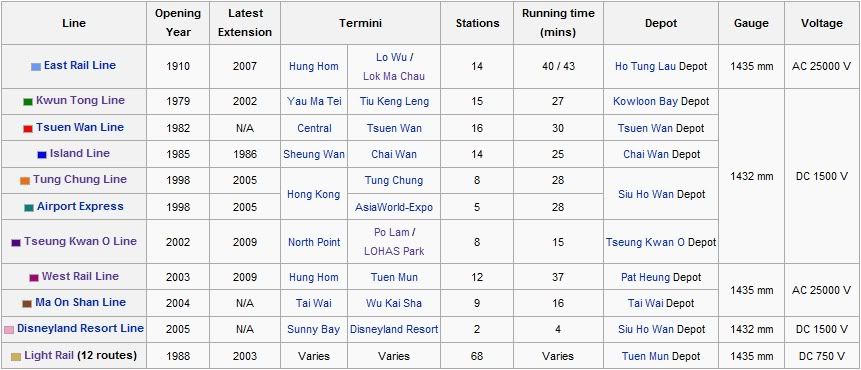
5 variations of Electric Multiple Unit rolling stock operate on the MTR network and 4 phases of Light Rail vehicles operate on the Light Rail network. All operate on 1432 mm rail gauge (near standard gauge) or 1435 mm (standard gauge). Except for the rolling stock of the Airport Express, all trains are designed with features to cope with high density passenger traffic on frequently used services, for example, seating arrangements, additional ventilation fans and etc.
5 doors are located on both sides of each compartment for East Rail Line standard class, Kwun Tong Line, Tsuen Wan Line, Island Line, Tung Chung Line, Tseung Kwan O Line, West Rail Line and Ma On Shan Line. 2 doors are located on both sides of each compartment for Airport Express and East Rail Line first class (only 1 is used). 3 doors are located on the left side of each Light Rail vehicle. All trains on East Rail Line consist of 12 compartments (11 standard class compartments and 1 first class compartment). All trains on Kwun Tong Line, Tsuen Wan Line, Island Line, Tung Chung Line, Airport Express and Tseung Kwan O Line consist of 8 compartments. All trains on West Rail Line consist of 7 compartments. All trains on Ma On Shan Line and Disneyland Resort Line consist of 4 compartments.Modernisation Trains (M-Trains)

The oldest model of MTR since its operation can be divided into different "Stocks". The M-Stock (or CM-Stock") of M-Train are the oldest trains on the MTR, built originally by Metro Cammell (now Alstom) and refurbished by United Goninan. The M-Train uses sliding doors, unlike K-Stocks and A-Stocks which use plug-doors. They are in service on Kwun Tong Line, Tsuen Wan Line, Island Line and Tseung Kwan O Line.
The Disneyland Resort Line uses driverless M-Train with their appearance overhauled to suit the atmosphere and theme of the line. Windows on each carriage and the handrails inside are made into the shape of Mickey Mouse's head, and there are bronze-made Disney characters decorating the interior of the carriages.
A-Stock trains
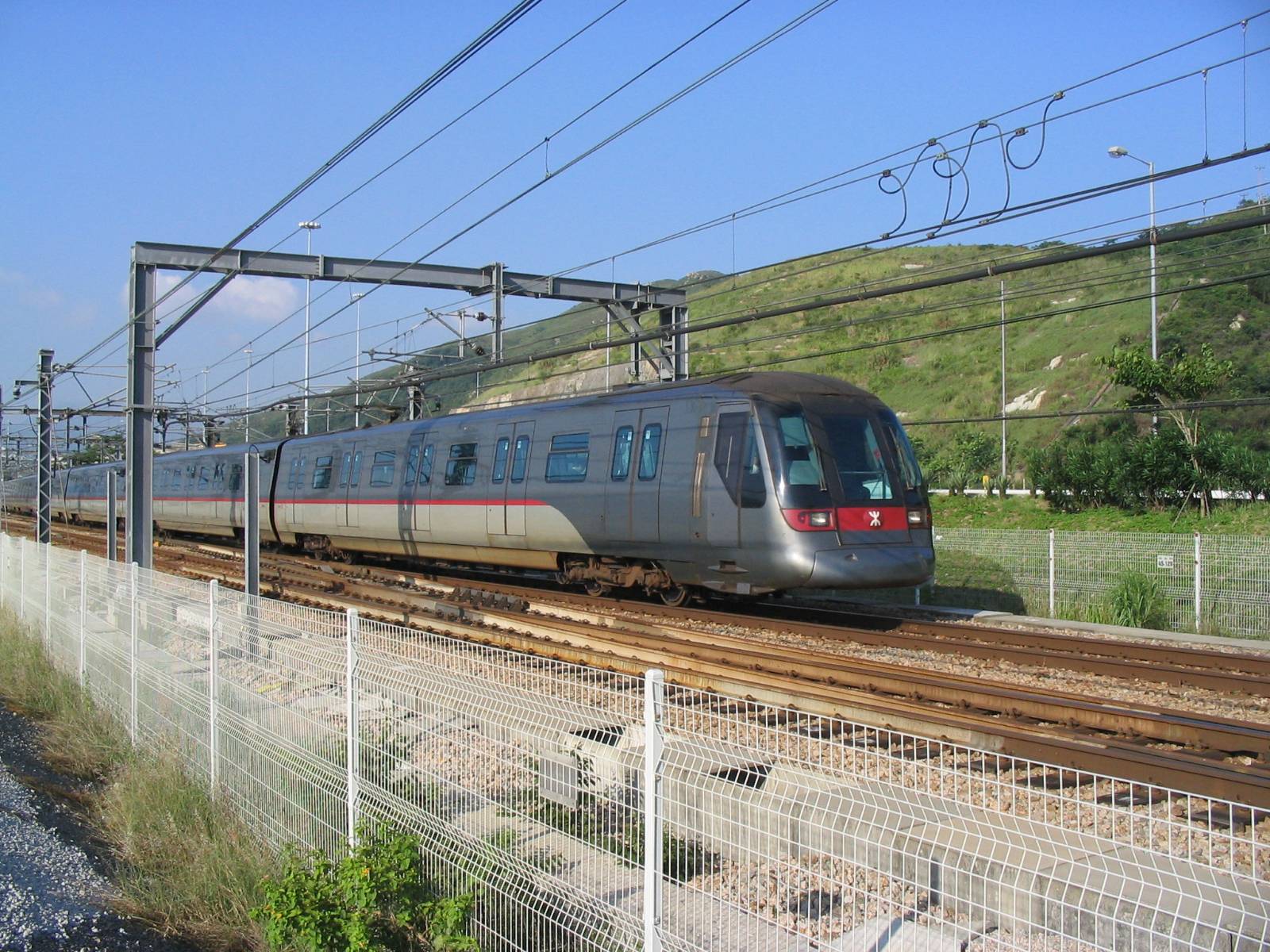
The Tung Chung Line and the Airport Express are operated by A-Stock specified to their respective lines. Initially running in 7-car formations, they have now been lengthened to eight cars. These two variations are built jointly by Adtranz (now Bombardier Transportation) and Construcciones y Auxiliar de Ferrocarriles (CAF) between 1994–97. Since 2006, K-Stock has also been used on the Tung Chung line.
K-Stock trains
The K-Stock are built jointly by Mitsubishi Heavy Industries and ROTEM, first put into service on the Kwun Tong Line with the hope of less noisy operation. Subsequently in 2006, four additional sets joined the Tung Chung Line to cope with the increasing passenger traffic. K-Stock trains have come under criticism when it was first put into service due to delays and door safety issues. There have been incidents where passengers have been injured by its doors and other service reliability issues have led to MTRCL "minimising the number of Korean trains for passenger service until a higher reliability of the systems concerned is achieved".
Future Changchun trains (Bombardier MOVIAs)
Apologies for small image. Mock-up only.The contract (C6554-07E) for 10 new set of trains was awarded to Changchun Railway Vehicles Co. Ltd in October 2008. The new MTR trains will be delivered to Hong Kong between 2011 and 2012 to enhance train frequency on the existing lines to cater for ongoing patronage growth on the existing Island Line, Kwun Tong Line, Tsuen Wan Line and Tseung Kwan O Line. These trains will feature new 22" LCD TVs, like their counterpart trains on former-KCR lines equipped with Newsline Express, offering better infotainment such as news and announcements.
SP1900 trains and East Rail Line Metro Cammell trains (MLR)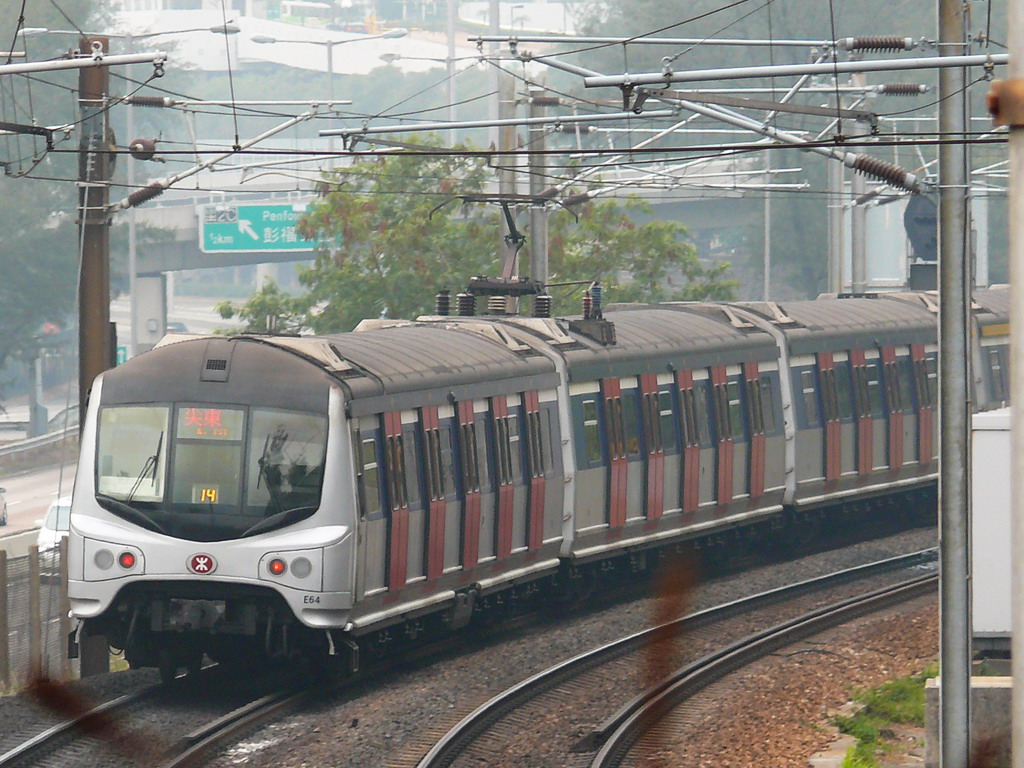

Both East Rail Line and West Rail Line use the SP1900 while Ma On Shan Line uses SP1950, a shorter model of the SP1900. The older Metro Cammell EMU are also used on East Rail Line. The electrification system used on these lines is 25 kV AC, 50 Hz, as opposed to the 1.5–kV DC used on the urban lines. Should the need arise in the future, dual voltage trains such as those utilised on Oresund Bridge shall be required.
These two models of rolling stock are from the former KCRC network (KCR East Rail, West Rail and Ma On Shan Rail). They did not receive major changes after the merger of the two companies except for the updated route map, the exterior company logo and such. The capability of these EMU fleet is similar to those on the urban network.
Light Rail vehicle
Rolling stocks running on Light Rail system were ordered from three different manufacturers, they are Commonwealth Engineering (Comeng), Kawasaki Heavy Industries and United Goninan. Designed to run on the standard gauge, 750V DC through overhead lines. Trams are usually operate with one or two carriages while the second carriage functions as trailer only. The arrangement allows each car to load approximately 300 units with 26 seats and four sets of perch seats provide flexible riding for passengers.
In addition, the Light Rail will be modernised as part of a 20th Anniversary Activity according to the MTR. Trains will include better disabled facilities as well as a totally new interior. The MTR will refurbish 69 older trains and buy 22 new ones. The first trains have been completed and are scheduled to be put into service in November. The whole project is expected to be completed in 2011.
-
The history of Hong Kong railways started in 1888.
When the British crown colony of Hong Kong began on the Hong Kong Island on 1842, there was no public transport. The first mode of public transport was the Peak Tram, a funicular railway, operated since 1888. The Hong Kong Tramways, a street-running tram system, started in 1904.
The Kowloon Canton Railway (now the East Rail Line on the MTR system) was built from the southern tip of Kowloon to Canton (now Guangzhou) in the Kwangtung Province (now Guangdong Province) in the 1900s. The British Section was opened in 1910, and the Chinese Section a year later. This is the first conventional railway in Hong Kong.
The Sha Tau Kok Railway was a 2 ft (610 mm) gauge narrow gauge railway running from Fanling to Sha Tau Kok in the northern New Territories of Hong Kong. The line began service on 1st April 1912. It was built with the narrow gauge tracks of the Kowloon-Canton Railway when the latter was converted to standard gauge. It ceased operation on April 1, 1928 when the Sha Tau Kok Road, a highway parallel to the railway, came into service. Some of the old rails and a tunnel can still be traced through the dense foliage of the countryside today.
After the closure of the line, two locomotives used on the railway were sold to the Philippines, where they were used in sugar mills. Subsequently they were repurchased and brought back to Hong Kong, where one is now on display in the Hong Kong Railway Museum. The other joined the collection of the Phyllis Rampton Trust in Wales.
Rapid transit in Hong Kong began in 1979 with part of the Modified Initial System of the MTR entered service. The section, then ran only between Shek Kip Mei and Kwun Tong stations, was subsequently extended and new lines were added by the operator, the Mass Transit Railway Corporation (later renamed MTR Corporation Limited, commonly branded as MTR Corporation).
In 1983, the British Section of the Kowloon-Canton Railway (now East Rail Line of the MTR) started to be electrified. Initially resembling the common design of regional railways except its high frequency, interior configuration of the EMU train cars were converted to the common design of metro or rapid transit systems. The West Rail and the Ma On Shan Rail were added to the KCR network in 2003 and 2004. All lines were leased by its former owner and operator Kowloon-Canton Railway Corporation (KCRC) to the MTR Corporation. -
The Peak Tramway is a funicular railway in Hong Kong, which carries both tourists and residents to the upper levels of Hong Kong Island. Running from Central district to Victoria Peak via the Mid-Levels, it provides the most direct route and offers good views over the harbour and skyscrapers of Hong Kong.
The Peak Tram is owned and operated by the Hongkong and Shanghai Hotels group (HSH), the owner of Hong Kong's famous Peninsula Hotel along with many other properties. The line, along with HSH's Peak Tower leisure complex at the line's summit, is promoted using the brand The Peak.
The Peak Tram's route from Central district to Victoria Peak covers a distance of about 1.4 kilometres and a height difference of just under 400 metres. The line has two pronounced curves, one to the left immediately after leaving the lower terminus, and the other to the right in the upper half of the ascent. The gradient also varies considerably throughout the ascent. It is a single track route and a passing loop, with two trams.
The lower terminus station, Garden Road, is located on Garden Road near St. John's Cathedral. The original station was incorporated into St. John's Building, an office tower, with the tram terminus at the ground level. The station comprises a single track, with platforms on both sides. One platform is used for boarding, the other for exiting the tram.
The upper terminus, The Peak is located below the Peak Tower shopping and leisure complex at Victoria Gap, some 150 metres below the summit of Victoria Peak. The station has the same arrangement of boarding and alighting platforms as the lower terminus. The haulage and control equipment for the funicular is located in a basement below the station.
There are also four intermediate stations, each of which consists of a single stepped platform and a shelter:- Kennedy Road. Located on Kennedy Road, named after Sir Arthur Edward Kennedy, a former Governor of Hong Kong.
- Macdonnell Road. Located on Macdonnell Road, named after Sir Richard MacDonnell, a former Governor of Hong Kong; depot located here and storage of historic car
- May Road. Located on May Road, named after Sir Francis Henry May, a former Governor of Hong Kong.
- Barker Road. Located on Barker Road, named after General George Digby Barker, a former military commander and acting administrator of Hong Kong.
As the intermediate stations are actually halts, trains will not stop there unless the Request Stop button is pushed.
In 1881 A. Findlay Smith first put the project of a Peak Railway into shape and presented a petition for a concession to the Governor of Hong Kong. The necessary legislation was passed two years later.
Mr. Findlay Smith did not approach the project rashly. Travelling extensively in Europe and America, he made himself conversant with nearly every existing method of railway employed for mountain ascent - San Francisco, Scarborough, Rigi, Monterey, Lucerne, the Rhine, Mount Vesuvius - and returned to Hong Kong thoroughly convinced of the feasibility of his idea. The actual construction was begun in September 1885 and in May 1888 the line was officially opened.
Alexander Findlay Smith's business partner, N.J. Ede, owned and lived in the house next to the Upper Terminus, originally named Dunheved, which they converted into the original Peak Hotel.
It took three years to build the Peak Tram, as much of the heavy equipment and rails had to be hauled uphill by the workers, who had no mechanical support. The Peak Tram was a revolutionary new form of transport to Asia at the time, and when the tramway was finally completed it was considered a marvel in engineering. A wooden structure was built for the terminal. According to photographs, the Garden Road terminus was originally an unadorned building, a large clock face was added to the edifice probably between the 1910s and 1920s.
The Peak Tram was opened for public service on 28 May 1888 by the then Governor Sir George William des Voeux. As built, the line used a static steam engine to power the haulage cable. It was at first used only for residents of Victoria Peak, although despite this it carried 800 passengers on its first day of operation, and about 150,000 in its first year. These passengers were carried in the line's wooden bodied cars. Its existence accelerated the residential development of Victoria Peak and the Mid Levels.
In the course of its history, the tram has been victim of two natural disasters, caused by floods from heavy rainfall, which washed away steep sections of the track between Bowen Road and Kennedy Road. The first was in 1899, and the second occurred on 12 June 1966.
The Peak Tram, Garden Road Terminus, c.1920
In 1926, the steam engine was replaced by an electric motor. On 11 December 1941, during the Battle of Hong Kong, the engine room was damaged in an attack. Service was not resumed until 25 December 1945, after the end of the Japanese occupation of Hong Kong.
In 1956, the Peak Tram was equipped with a new generation of lightweight metal bodied cars, each of which seated 62-seat passengers. Unusually for a funicular line, three such cars were provided, only two of which were in use at any one time. The third spare car was kept in a car shed near Kennedy Road station.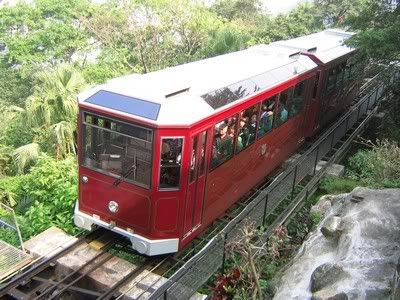
The system was comprehensively rebuilt in 1989 by the Swiss company, Von Roll, with new track, a computerized control system and two new two-car trams with a capacity of 120 passengers per tram. By the time of the handover in 1997, it carried some 2 million passengers annually. Today, more than 4 million people ride the Peak Tram annually, or an average of over 11,000 every day.
The Tramways operated on the principle of two coaches moving in opposite directions balancing each other; at the same time they were aided by a motor driven cable. Except for the middle section, where the two coaches pass each other in a dual-track configuration, there is a single track for most of the length of the tramway.
The line has the following technical parameters:
Length: 1364 metres
Height: 368 metres
Maximum Steepness: 48%
Track Gradient: 4 ~ 27 degrees
Fleet: 2 2-car train sets
Capacity: 120 passengers per train set
Configuration: Single track with passing loop
Journey time: 4.9 minutes
Maximum speed: 6 metres per second
Track gauge: 4'11.85" foot (1520 mm)
Traction: Electricity -
Hong Kong Tramways is a tram system in Hong Kong and one of the earliest forms of public transport in Hong Kong. It is notable for being one of the three tramways in the world that have regular operation of double-decker trams—the others being Blackpool tramway, in England and the Alexandria Tram system in Egypt—and is the only system that runs exclusively using double-decker trams.
Owned and operated by Veolia Transport, the tramway runs on Hong Kong Island in Hong Kong between Shau Kei Wan and Kennedy Town, with a branch circulating Happy Valley. Each day 240,000 residents commute by tram. Trams in Hong Kong have not only been a form of transport for over 100 years, but also a major tourist attraction.
The electric tram system was proposed in 1881; however nobody was willing to invest in a system at the time. In August 1901, the Second Tramway Bill was introduced and passed into law as the 1902 Tramway Ordinance. Hong Kong Tramway Electric Company Limited, a British company, was authorised to construct and operate the system. It was soon taken over by the Electric Traction Company of Hong Kong Limited on 30 July 1904, and the name was changed to Hong Kong Tramways Company Limited in 1910.
A boycott in November 1912 followed the company's refusal to accept Chinese coins in payment for fare. What initially was a peaceful protest grew into intimidation, violence, arrests and attacks on (apparently exclusively) Chinese passengers.
In 1922, a new company, Hong Kong Tramway Limited (HKT), was founded to take over and operate the system. The Tramway Ordinance of 1902 had awarded a 25-year operating mandate, which was then extended to a 50-year contract and expired on 23 May 1952. Due to the extension of the mandate, the Hong Kong Government had the chance to purchase the tramway at 5-year intervals, provided always that 6 months' notice of such intention was given. In 1974, Hong Kong Tramways became part of the Hong Kong and Kowloon Wharf and Godown Company Limited and is now operated under subsidiary Wharf Transport Investments Ltd.
The Hong Kong Tramways system was built from May 1903 (see timeline below). After equipment testing, the electric tram began operation on 30 July 1904. At that time the main route went along the northern waterfront of Hong Kong Island from Arsenal Street in Wan Chai to Shau Kei Wan, with a branch serving Happy Valley. Shortly after, the line was extended westwards to Kennedy Town. The length of the route was 15 km (9.3 miles), the same as today, except for track relocations and the extension of the Happy Valley branch in 1914. Originally constructed with both single and double-track sections, the last single-track section was eliminated in August 1949. Reserved track along Queensway (then part of Queen's Road East) was introduced from 1955.
In the late 1970s and early 1980s there were fears about the survival of the trams when the Mass Transit Railway began to construct the Island Line, which was proposed to run along a route that is similar to the trams'. A survey was taken by the company in 1984, and the results concluded that the public would prefer to keep the tram system intact.
On 7 April 2009, Veolia Transport obtained a 50% stake and the operating rights of the Tramway for a sum more than €10 million but "far less" than €100 million. It also got an option to purchase the other 50%. Veolia exercised the option and will purchase the remaining 50% in March 2010.
The system is 13 km (8 miles) long, with a total track length of 30 km (18.6 miles), and in many places it runs together with other vehicles on the street. Its operation is from the 550 V direct current (d.c.) from the overhead cables, on a 3'6" gauge (1067 mm) tracks. The trams provide services to only part of Hong Kong Island: they run on a double track along the northern coast of Hong Kong Island from Kennedy Town to Shaukeiwan, with a single clockwise-running track of about 3 km (1.9 miles) around the Happy Valley Racecourse.
Routes
Shau Kei Wan ↔ Western Market
Shau Kei Wan ↔ Happy Valley
North Point ↔ Whitty Street
Happy Valley ↔ Kennedy Town
Causeway Bay ↔ Kennedy Town
Western Market ↔ Kennedy Town
Most of the tram stop locations have remained unchanged since their establishment. However, some have had their names changed, e.g. "Shu Shen Guan" (Chinese 書信館, General Post Office) in the 1940s is now "World-Wide House", due to redevelopment of the former Post Office site. In 1934, Hongkong Tramways introduced loading islands (waiting areas) at some busy tram stops to ensure the safety of passengers. Today, there are 123 tram stops in total. Most of them are sheltered, with a handful of tram stop signs still standing on the sidewalks.
Just like buses, trams in Hong Kong can be very crowded. The maximum capacity of each tramcar is 115 people. During the busier periods of the day, trams often line up since there are many tramcars running at the same time. In 2002, the trams recorded an average of 240,000 passenger trips daily.
There are seven terminal points, at Kennedy Town, Whitty Street, Western Market, Causeway Bay, North Point, Shaukeiwan and Happy Valley. Tram stops are densely located in an average interval of 250 metres (820 ft). Most of them are located in the middle of the road, connected by pedestrian crossings or footbridges. Major ones include Yee Wo Street stop at Causeway Bay, Pacific Place stop at Admiralty, and Prince's Building / The Landmark stop at Central. Travelling in the lower deck of the tram allows travellers to have a close up view of the local street life, while occupying the front seats of the upper deck gives good views of the town as the tram rattles by.
The tram service starts at 05:10 and ends at around 00:30 every day. On average, the interval between each tram is approximately 1.5 minutes in peak hours.
In the past, trams only have a maximum speed of 40 km/h. But starting from the beginning of 2008, the speed of some trams is increased. Now most trams have a maximum speed of 50 km/h, a few of them even have a maximum speed of 60 km/h.
Many terminal stations of the Hong Kong Tramways are on balloon loops. This enables the trams to reverse its travel direction more efficiently.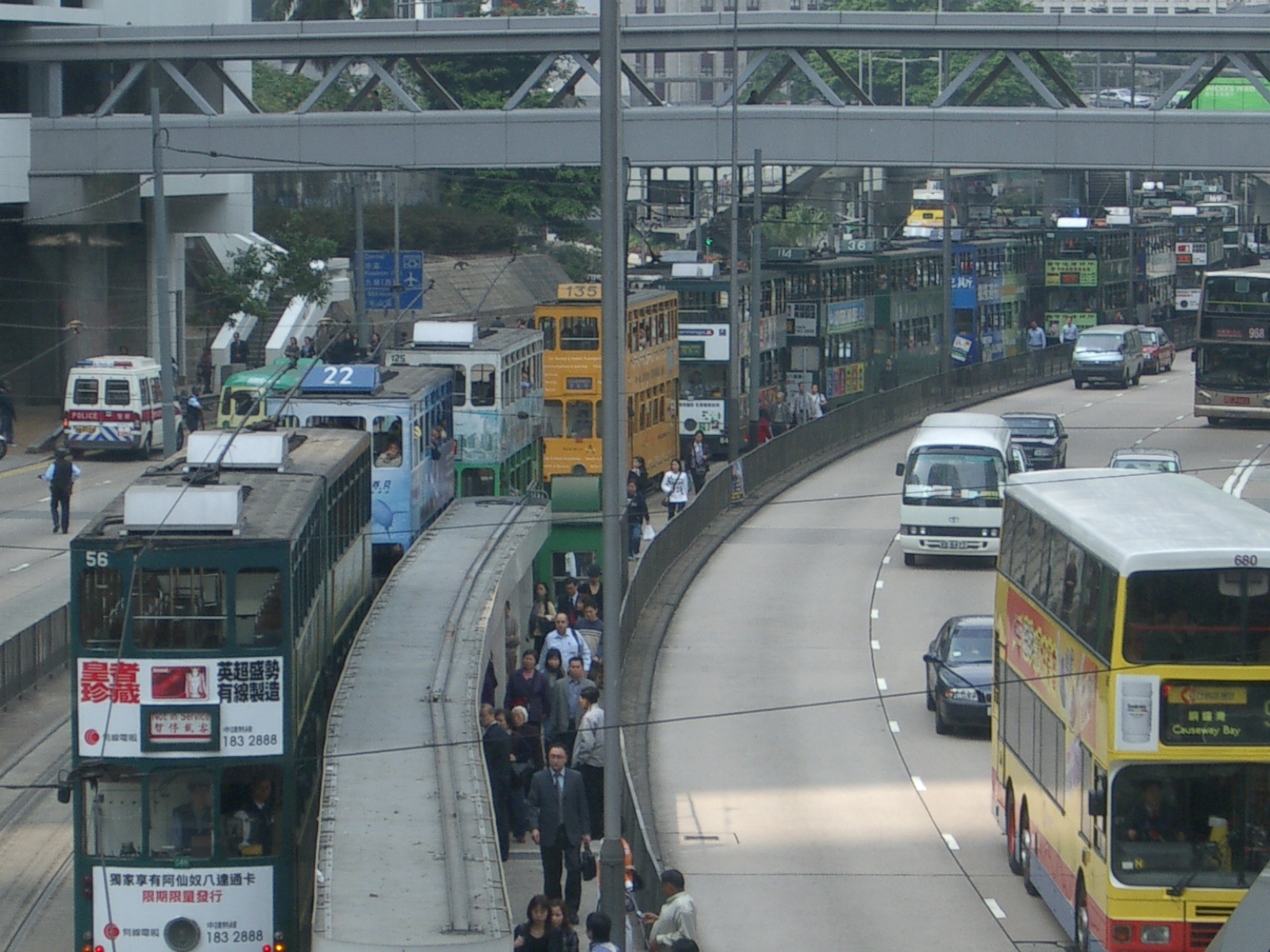
Hongkong Tramways Ltd now owns 163 double-decker trams, including two open-balcony trams ( Fleet numbers 28 and 128 ) for tourist trips and private hire and there is also a maintenance tram with fleet number 200. The trams themselves are sometimes called the “DingDing” by Hong Kong people, after the double bell ring trams use to warn pedestrians of their approach. Hong Kong is the only fully double-decker tram fleet in the world. Most of the trams in operation were rebodied in the late 1980s or early 1990s. They are equipped with sliding windows. Since the early 2000s these trams have been upgraded to provide better operating performance and safety.
Tram 120 is the only tram still maintaining the original 1950s' double-deck design. The cabin is varnished with its' original light-green color with teak-lined windows and rattan seats.
In 2000, 3 new aluminium alloy metal bodied trams (officially called "Millennium trams"), #168 - 170, started operation. These trams have proven quite unpopular due to the poor ventilation in the summer - unlike before the front screen window cannot be opened to improve air-flow to passengers. A prototype air-conditioned tram, number 171, is under testing but is also not popular.
The tram fleet first consisted of 26 single-deck trams, with bodies 29 ft (8.8 m) long and 6 ft 1 in (1.9 m) wide, imported from England. However, they were quickly removed because of the rapid modernisation programmes. These tramcars were replaced by open-top double-deck tramcars from 1912 onwards. The introduction of permanent roofs for trams in 1923 was a big improvement to the system. In 1960s, adding trailers was proposed due to the increasing population and demands. In December 1964, after testing a prototype built by Taikoo Dockyard in Hong Kong, 10 trailers were ordered from England and were added to the trams in Hong Kong in early 1965. Ten additional trailers were ordered from England in 1967, bringing the total number of trailers to 22 but they were all were withdrawn. and scrapped. at the end of 1982 since they were not economical to run - requiring a separate conductor - and used to de-rail frequently.
In 2007, a new works car, number 200, which - as well as outside maintenance on the tracks - is also used to move trams in the depot was constructed. Besides using normal power, it can also use a diesel motor for working. Also starting from November 07, a new driving panel has been installed on trams after they have been refurbished. The first tram on this program was number 38.
In 2008, an air-conditioner was installed on the 'antique' tram #128.
Fares on the trams are low by local standards. The fare is HK$2 for adults, and HK$1 for children under 12 and senior citizens 65 and above. Unlike other forms of public transport in Hong Kong, there is a uniform tariff regardless of the distance travelled. Passengers pay by either inserting exact fare or using the Octopus card when alighting. Monthly tickets are also available at the cost of HK$170, sold at Whitty Street tram depot and Causeway Bay and North Point termini at the end of each month.
Ordinary and antique trams are also available for private hire. The open-balcony antique trams are available for parties or promotional events. Tourists can also travel the open-top trams through tours organised by the Hong Kong Tourism Board.